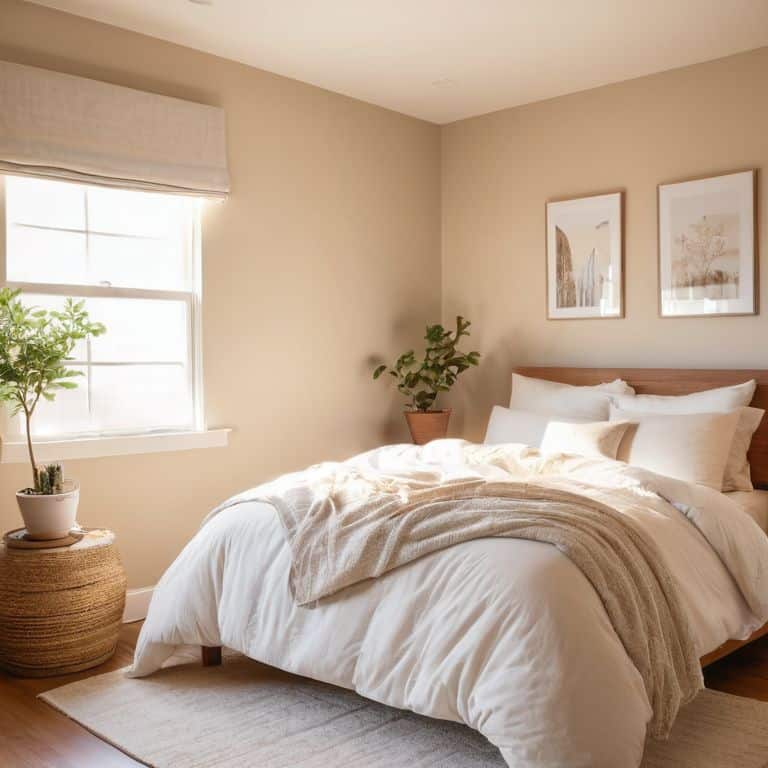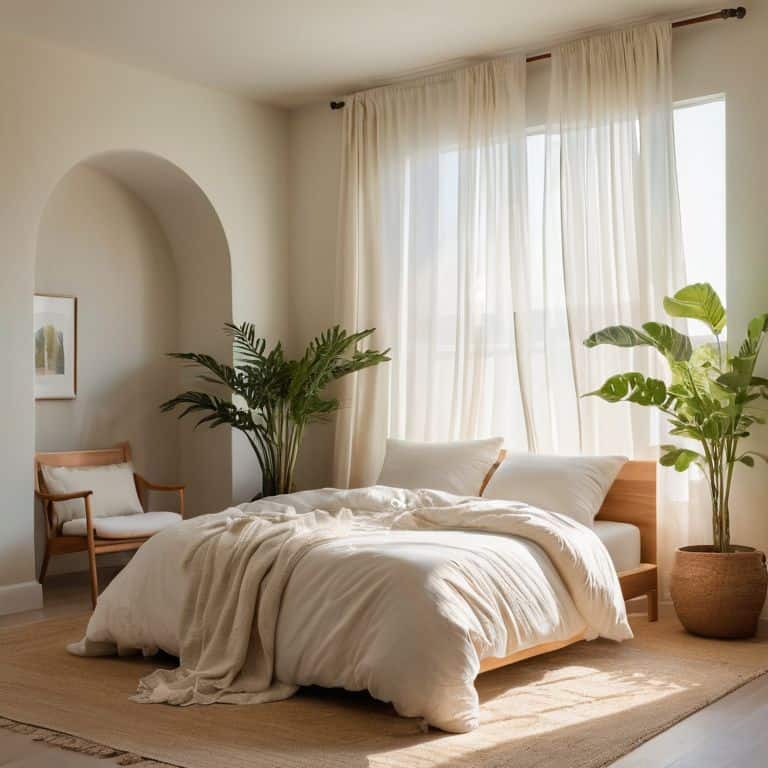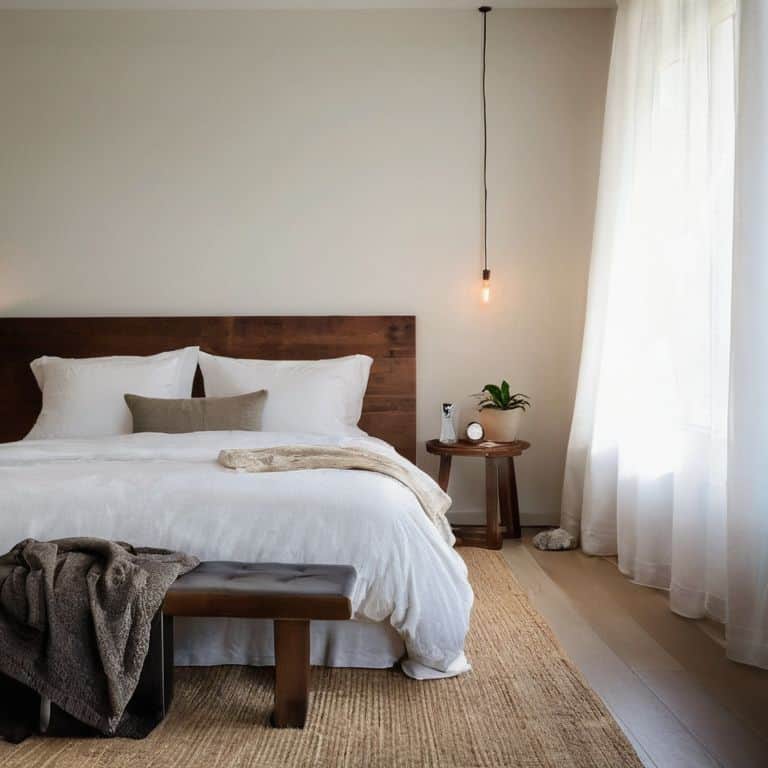I still remember the first time I created a screen-free bedroom in my own home – it was like a weight had been lifted off my shoulders. The benefits of a screen-free bedroom are often touted as a cure-all for better sleep and productivity, but I’ve found that it’s about more than just banning devices from the bedroom. It’s about creating a sanctuary that nurtures both body and mind. In my experience, the benefits of a screen-free bedroom are deeply connected to the concept of purposeful living, where every object and action has a clear intention behind it.
As someone who’s worked with numerous clients to declutter and organize their living spaces, I’ve seen firsthand the impact that a well-designed bedroom can have on a person’s mental and emotional well-being. In this article, I’ll share my no-nonsense approach to creating a screen-free bedroom that truly feels like a retreat from the world. I’ll provide you with practical, experience-based advice on how to make the transition, from assessing your current sleep environment to implementing simple yet effective strategies for maintaining a screen-free space. My goal is to help you create a bedroom that not only promotes better sleep but also cultivates a sense of calm and clarity that stays with you long after you’ve left the room.
Table of Contents
Unlocking Peaceful Nights

As I reflect on my own journey to creating a serene sleeping space, I realize that bedroom ambiance for relaxation is crucial for a restful night’s sleep. By removing screens from my bedroom, I’ve been able to craft a calming environment that signals to my mind that it’s time to unwind. This simple change has had a profound impact on my ability to fall asleep and stay asleep, allowing me to wake up feeling refreshed and rejuvenated.
One of the primary reasons a screen-free bedroom is so effective is that it helps to reduce exposure to blue light at night. This type of light, which is emitted by smartphones, tablets, and computers, can suppress the production of melatonin, making it harder to fall asleep. By avoiding screens for at least an hour before bedtime, I’ve been able to improve my sleep hygiene practices and establish a consistent sleep schedule. This, in turn, has helped to regulate my body’s internal clock and improve the overall quality of my sleep.
To take your bedroom to the next level, consider designing a calming bedroom environment that promotes relaxation and reduces stress. This can be as simple as adding some soothing colors, comfortable bedding, or a few well-placed plants. By creating a peaceful atmosphere, you can help to quiet your mind and prepare your body for a restful night’s sleep. Remember, the goal is to create a tech-free zone that allows you to disconnect from the world and recharge for the day ahead.
Designing Ambiance for Relaxation and Rest
To create a truly restful atmosphere, I recommend soft lighting that mimics the warmth of a sunset. This can be achieved with table lamps or floor lamps with warm-toned shades, helping to signal to the brain that it’s time to unwind. As someone who enjoys cultivating bonsai trees, I’ve come to appreciate the calming effects of gentle, indirect light on both plants and people.
In my own home, I’ve found that calm colors on the walls can greatly contribute to a sense of serenity. Soothing hues such as light gray, beige, or pale blue can help quiet the mind and prepare the body for a restful night’s sleep. By combining these visual elements with the absence of screens, you can craft a bedroom that truly feels like a sanctuary.
Sanctuary in the Shadows Reducing Blue Light
As I sit in my own bedroom, surrounded by the gentle glow of table lamps, I’m reminded of the impact blue light can have on our sleep patterns. It’s a phenomenon that’s both fascinating and frustrating, as our devices emit a light that can trick our brains into thinking it’s still daytime. By removing screens from our bedrooms, we can begin to create a sleep-conducive environment that signals to our minds that it’s time to wind down.
In the shadows of a screen-free bedroom, I’ve found that peaceful slumber becomes a more accessible reality. The absence of blue light allows our bodies to produce melatonin, the sleep hormone, more naturally, leading to a restful night’s sleep and a clearer mind come morning.
The Benefits of a Screen Free Bedroom

As I reflect on my own journey to creating a serene living space, I realize that one of the most significant transformations occurred when I made my bedroom a tech-free zone. It’s astonishing how such a simple decision can have a profound impact on the quality of sleep and overall sense of calm. By eliminating the glow of screens, I’ve been able to design a calming bedroom environment that signals to my mind that it’s time to unwind.
The effects of screen time on sleep are well-documented, and it’s clear that reducing exposure to blue light at night is crucial for improving sleep hygiene practices. When we surround ourselves with screens before bed, we’re essentially telling our brains to stay alert and focused, rather than relaxing and rejuvenating. By creating a screen-free bedroom, we can break this cycle and allow our minds to drift off into a peaceful slumber.
In my experience, the key to making this transition is to focus on designing ambiance for relaxation and rest. This can be as simple as using soft lighting, calming colors, and soothing textures to create a space that feels like a true sanctuary. By doing so, we can transform our bedrooms into a haven that nourishes both body and mind, and wake up feeling refreshed, renewed, and ready to take on the day.
Calming Environments Silence for the Mind
As I sit in my own screen-free bedroom, surrounded by the gentle glow of table lamps and the soft scent of essential oils, I’m reminded of the power of calming environments in silencing the mind. The absence of screens allows my brain to unwind, letting go of the constant stream of information and stimuli that can be overwhelming.
In this peaceful space, I find that my mind is able to drift into relaxation, letting go of the stresses and worries of the day. The silence is almost palpable, a physical presence that envelops me in a sense of serenity, and I believe this is essential for a restful night’s sleep and a clearer mind.
Improving Sleep Hygiene With Tech Free Zones
As I work with clients to create their ideal sleeping spaces, I often recommend establishing tech-free zones within the home. This can be as simple as designating the bedroom as a device-free area, or it can involve creating a phone-free reading nook or meditation corner. By doing so, we can begin to associate certain spaces with relaxation and disengage from the constant stream of notifications and distractions.
Creating a screen-free bedroom is just the beginning – it’s about cultivating a mindset that values rest and relaxation. I encourage my clients to think about silent evenings, where the focus is on unwinding and preparing for a restful night’s sleep, rather than mindlessly scrolling through screens.
Embracing Serenity: 5 Essential Tips for a Screen-Free Sanctuary
- Create a bedtime routine that signals the end of screen time, allowing your mind to unwind and prepare for rest
- Designate the bedroom as a tech-free zone, using alarm clocks and other devices that don’t emit blue light to create a sleep-conducive environment
- Opt for soft, warm lighting to foster a calming ambiance, making it easier to fall asleep and stay asleep
- Invest in blackout curtains or shades to block out external light sources, further enhancing the sleep-friendly atmosphere
- Establish a ‘no work’ policy in the bedroom, reserving the space for relaxation and intimacy to help calm your mind and promote restful sleep
Embracing the Sanctuary: Key Takeaways
By creating a screen-free bedroom, you can significantly reduce exposure to blue light, which disrupts sleep patterns, and instead design an ambiance that fosters relaxation and rest
Establishing tech-free zones in your home, starting with the bedroom, can improve sleep hygiene by training your brain to associate the space with sleep and tranquility, leading to a clearer and more focused mind
Silence and calm environments are crucial for mental health; a screen-free bedroom encourages a digital detox, helping to quiet the mind, reduce stress, and create a true sanctuary that nurtures both body and soul
A Sanctuary of Silence
As we surrender our bedrooms to the soft glow of darkness, we invite the stillness of the night to heal our minds and rejuvenate our souls.
Nathan Reed
Embracing the Sanctuary Within

As we’ve explored the benefits of a screen-free bedroom, it’s clear that creating a peaceful sanctuary is within our reach. By reducing blue light, designing ambiance for relaxation, and establishing tech-free zones, we can significantly improve our sleep hygiene and calm our minds. The key is to make intentional decisions about the space we inhabit, recognizing that our surroundings have a profound impact on our well-being. By doing so, we can unlock deeper relaxation and a more restful night’s sleep, leading to a clearer and more focused mind.
As you consider transforming your bedroom into a screen-free haven, remember that it’s a journey worth taking. It’s an opportunity to reclaim your space and prioritize your mental and emotional well-being. By embracing this simple yet profound change, you can create a sanctuary that nurtures your mind, body, and spirit. So, take the first step tonight, and discover the peaceful refuge that awaits you in the stillness of a screen-free bedroom.
Frequently Asked Questions
How can I ensure my bedroom remains screen-free if my partner or family members are used to watching TV or scrolling through their phones before bed?
To maintain a screen-free sanctuary, I recommend having an open conversation with your partner or family members about your goals and boundaries. Suggest alternative relaxation methods, like reading or meditation, and consider designating a separate area for screen time before bed. This way, you can respect each other’s habits while preserving your bedroom as a peaceful retreat.
What are some alternative relaxation techniques I can use in place of screen time before bed to help me unwind?
For a serene unwind, I recommend trying progressive muscle relaxation, gentle stretches, or guided meditation. You can also listen to calming ambient music or nature sounds, like rain or ocean waves, to quiet your mind and prepare your body for rest.
Will implementing a screen-free bedroom have a significant impact on my overall mental health and stress levels, or are the benefits more related to sleep quality?
While a screen-free bedroom primarily enhances sleep quality, its benefits can also seep into overall mental health and stress levels. By creating a serene environment, you’re not just improving sleep, but also cultivating a space that calms your mind, reducing anxiety and promoting relaxation, which in turn can have a positive impact on your mental wellbeing.
